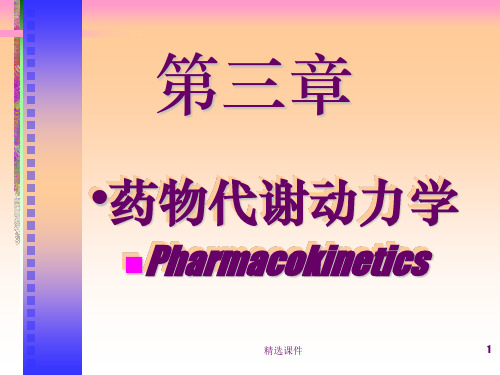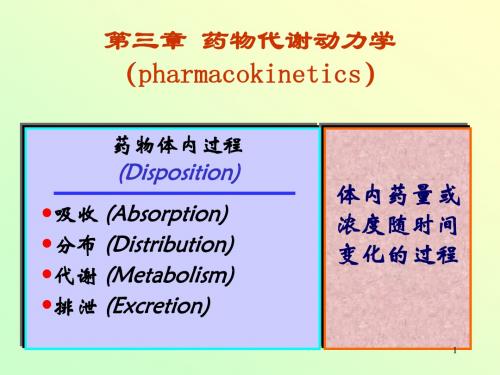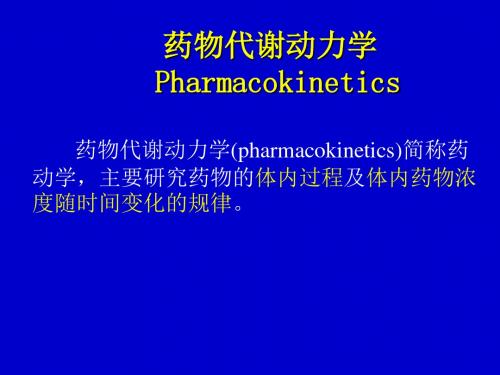药物代谢动力学课件
合集下载
药物代谢动力学(修正)PPT课件

CHAPTER
药物代谢动力学研究的发展趋势
药物代谢动力学与药效学、药代学、毒理学等多学科的交叉研究,有助于更全面地了解药物在体内的吸收、分布、代谢和排泄过程,为新药研发和临床用药提供更科学、更准确的指导。
跨学科的研究团队和合作机制的建立,可以整合不同领域的专业知识和技术,提高研究效率和成果质量。
多学科交叉研究
随着科技的不断进步,新的技术和方法在药物代谢动力学研究中得到广泛应用。例如,高通量测序技术、质谱技术、核磁共振技术等,可以更准确、更快速地检测和分析药物在体内的代谢产物和代谢过程。
新技术的应用有助于提高药物代谢动力学研究的效率和准确性,缩短新药研发周期,降低研发成本。
新技术新方法的应用
药物代谢动力学与临床药学结合,可以更好地将研究成果应用于临床实践,提高药物的疗效和安全性。
意义
计算方法
用于评估药物在体内的代谢和排泄速率,从而指导临床用药。
通过药代动力学模型计算得出。
03
02
01
速率常数
指当药物在体内达到动态平衡后,体内药量与血药浓度的比值。
定义
用于评估药物在体内的分布情况,从而了解药物的作用部位和作用范围。
意义
与药物的脂溶性、组织亲和力等有关。
影响因素Βιβλιοθήκη 表观分布容积影响代谢的因素
描述药物代谢速度的参数。
代谢速率常数
药物的代谢
药物及其代谢产物从体内排出的过程。
排泄的定义
排泄方式
影响排泄的因素
排泄速率常数
尿液、胆汁、汗液等。
肾小球滤过率、肝肠循环等。
描述药物排泄速度的参数。
药物的排泄
03
CHAPTER
药物代谢动力学参数
描述药物在体内代谢、排泄速度的常数。
药物代谢动力学研究的发展趋势
药物代谢动力学与药效学、药代学、毒理学等多学科的交叉研究,有助于更全面地了解药物在体内的吸收、分布、代谢和排泄过程,为新药研发和临床用药提供更科学、更准确的指导。
跨学科的研究团队和合作机制的建立,可以整合不同领域的专业知识和技术,提高研究效率和成果质量。
多学科交叉研究
随着科技的不断进步,新的技术和方法在药物代谢动力学研究中得到广泛应用。例如,高通量测序技术、质谱技术、核磁共振技术等,可以更准确、更快速地检测和分析药物在体内的代谢产物和代谢过程。
新技术的应用有助于提高药物代谢动力学研究的效率和准确性,缩短新药研发周期,降低研发成本。
新技术新方法的应用
药物代谢动力学与临床药学结合,可以更好地将研究成果应用于临床实践,提高药物的疗效和安全性。
意义
计算方法
用于评估药物在体内的代谢和排泄速率,从而指导临床用药。
通过药代动力学模型计算得出。
03
02
01
速率常数
指当药物在体内达到动态平衡后,体内药量与血药浓度的比值。
定义
用于评估药物在体内的分布情况,从而了解药物的作用部位和作用范围。
意义
与药物的脂溶性、组织亲和力等有关。
影响因素Βιβλιοθήκη 表观分布容积影响代谢的因素
描述药物代谢速度的参数。
代谢速率常数
药物的代谢
药物及其代谢产物从体内排出的过程。
排泄的定义
排泄方式
影响排泄的因素
排泄速率常数
尿液、胆汁、汗液等。
肾小球滤过率、肝肠循环等。
描述药物排泄速度的参数。
药物的排泄
03
CHAPTER
药物代谢动力学参数
描述药物在体内代谢、排泄速度的常数。
药理学第三章-药物代谢动力学PPT课件

药物的相互作用
多种药物同时使用可能会产生相互作用,影响药物的代谢和 排泄。
例如,某些药物可能会抑制或诱导其他药物的代谢酶,导致 药物浓度过高或过低。
05
药物代谢动力学在临床上的应用
个体化给药方案的设计
根据患者的年龄、体重、性别、生理状态等因素, 制定个体化的给药方案,确保药物剂量和用药方式 的合理性和安全性。
考虑患者的遗传因素和基因多态性对药物代谢的影 响,为不同个体提供针对性的给药方案。
监测患者的药物代谢情况,及时调整给药方案,确 保治疗效果和减少不良反应的发生。
药物疗效的预测与评估
02
01
03
通过药物代谢动力学的研究,了解药物在体内的吸收 、分布、代谢和排泄过程,预测药物疗效。
结合患者的病情和临床指标,评估药物治疗的效果, 为临床医生提供科学依据。
消除速率常数(Ke)
总结词
表示药物在体内消除的速度常数,是评价药物消除快慢的重要参数。
详细描述
消除速率常数(Ke)是药代动力学的一个参数,用于描述药物在体内消除的速度。 Ke值越大,表示药物的消除速度越快。药物的Ke值受到多种因素的影响,如代谢速 率、排泄速率等。在药代动力学模型中,Ke用于描述一级消除过程。
二室模型
定义
二室模型是指药物在体内存在两个不同的分布相,即中央室和周边室。中央室指药物进入 血液循环后迅速分布到全身各组织器官,而周边室则指药物在某些组织器官中的缓慢分布 。
特点
二室模型适用于药物在体内分布不均匀,且消除速率在不同组织器官中存在差异的情况。
应用
二室模型常用于描述药物的分布过程,以及用于计算药物的表观分布容积、清除率等药动 学参数。
药理学第三章-药物代谢动力 学ppt课件
药物代谢动力学 PPT课件

二、药物的体内过程
§1-3 药物代谢动力学
2.与组织的亲和力 有些药物与某些组织有较高的亲和力,使药物在该
组织中具有较高的浓度,如碘主要集中在甲状腺,而 氯喹在肝脏中浓度较高。 3.局部器官血流量
血流量大的组织、器官,药物分布的较多。
二、药物的体内过程
§1-3 药物代谢动力学
4. 药物的理化性质和体液pH
§1-3 药物代谢动力学
二、药物的体内过程
§1-3 药物代谢动力学
影响药物分布的因素主要有:
1.与血浆蛋白结合
特点:①结合是可逆的;②结合型的药物分子量加大,不易 透出血管壁,使其不易转运,故暂时失去药理活性;③具 有饱和现象;④两种以上的药物可能与同一蛋白结合而发 生竞争性抑制。
药物与血浆蛋白结合后,影响其分布,故血浆蛋白 结合率高的药物起效慢、作用维持时间长,而血浆蛋白结 合率低的药物起效快、作用维持时间短。
药物的分子越小、脂溶性越高、解离度越小、溶解度越大。, 越容易被吸收;反之则难吸收。 弱酸性药物在胃中易吸收,而弱碱性药物在小肠中易吸收。 药物吸收与排泄的规律:酸酸碱碱促吸收,酸碱碱酸促排泄。 (2)吸收环境
口服给药时,胃的排空、肠蠕动的快慢、胃肠内容物的多少 及性质都可影响药物的吸收。
改变吸收环境的pH可使药物解离,影响药物的吸收。
转运的作用力来自于细胞膜两侧的浓度梯度,浓度差越大, 转运速度越快。大多数药物在体内的转运为被动转运 。
大家学习辛苦了,还是要坚持
继续保持安静
一、药物的跨膜转运
§1-3 药物代谢动力学
一、药物的跨膜转运
§1-3 药物代谢动力学
2.主动转运 药物逆浓度差转运,从浓度低的一侧向浓度高的一侧转运
特点:
药理学第2章药物代谢动力学PPT课件

影响药物排泄的因素
肾功能
肾排泄是药物排泄的主要途径,肾功能不全 会影响药物的排泄速度和能力。
肝功能障碍
肝脏是药物代谢的主要器官,肝功能障碍会 影响胆汁排泄。
年龄
儿童和老人的肾功能相对较弱,药物的排泄 速度较慢。
遗传因素
某些药物的排泄速度存在个体差异,与遗传 因素有关。
药物排泄的研究方法
尿液检测
通过收集尿液并测定其中的药物浓度,可以了解 药物排泄的速度和量。
胆汁检测
通过收集胆汁并测定其中的药物浓度,可以了解 胆汁排泄的情况。
皮肤排泄研究
通过皮肤分泌物的测定,可以了解某些药物通过 皮肤排泄的情况。
THANK YOU
感谢聆听
制剂因素
药物的剂型、制备工艺、辅料等 也会影响其吸收。例如,药物的 溶解度、溶出速率等会影响其在 体内的吸收。
80%
生理因素
胃肠道的pH值、胃排空速率、肠 道蠕动等生理因素也会影响药物 的吸收。此外,人体的新陈代谢 和排泄也会影响药物的吸收。
药物吸收的研究方法
动物实验
通过给动物用药,观察其体内 药物浓度的变化,从而了解药 物的吸收特性。
药物代谢动力学的重要性
指导临床合理用药
通过了解药物的代谢动力学特性,可以制定合理的 给药方案,提高治疗效果并降低不良反应的发生率 。
促进新药研发
了解药物的代谢动力学特性是新药研发的重要环节 ,有助于发现潜在的药物候选者并进行优化。
保障用药安全
通过药物代谢动力学研究,可以评估药物的疗效和 安全性,为保障用药安全提供科学依据。
生理屏障
如细胞膜、血脑屏障等生理屏障限制某些药物的 分布。
药物分布的研究方法
01
药物代谢动力学学PPT课件

药物代谢的酶系统
药物代谢的类型与产物
氧化反应
通过加氧的方式将药物转化为极性更强的代谢物,易于排泄。例如,苯妥英钠在肝内氧化为苯妥英。
还原反应
通过加氢的方式将药物还原为更易排泄的形式。例如,硝苯地平在肝内还原为硝苯啶。
水解反应
通过加水的方式将药物分解为更易排泄的形式。例如,阿司匹林在肝内水解为水杨酸。
中药代谢动力学研究
THANKS
感谢您的观看。
半衰期计算公式
半衰期可以反映药物在体内的消除速度,对于制定给药方案和调整用药剂量具有重要的指导意义。同时,半衰期也是判断药物是否易于蓄积中毒的重要依据。
半衰期的意义
半衰期计算
07
CHAPTER
药物代谢动力学在临床上的应用
根据患者的生理、病理状况和药物代谢特征,制定个体化的给药方案,确保药物疗效和安全性。
药物代谢动力学学ppt课件
目录
药物代谢动力学概述 药物吸收 药物分布 药物代谢 药物排泄 药物代谢动力学参数计算 药物代谢动力学在临床上的应用
01
CHAPTER
药物代谢动力学概述
药物代谢动力学是研究药物在体内吸收、分布、代谢和排泄的学科,主要关注药物在体内的动态变化过程。
药物代谢动力学对于新药研发、临床合理用药、药物疗效和安全性评价等方面具有重要意义,是药理学和药物治疗学的重要基础。
清除率的意义
03
清除率可以反映机体对药物的代谢能力,是制定给药方案的重要依据。
清除率计算
1
2
3
表观分布容积是指药物在体内达到动态平衡时,体内药量与血浆药物浓度的比值,是反映药物在体内分布广度的指标。
表观分布容积定义
表观分布容积(Vd)= (总药量)/(血浆药物浓度),其中总药量和血浆药物浓度可通过实验测定。
药物代谢动力学ppt课件

4、经皮给药 脂溶性 促皮吸收剂
精选课件
15
精选课件
16
吸收速度与程度主要取决于药物的理
化性质、剂型、剂量和给药途径。 1)消化道吸收 (1)口腔粘膜:脂溶性药物如硝酸甘油 (舌下给药)以简单扩散方式被吸收。 (2)胃:小的水溶性分子如酒精可自胃
粘膜吸收。 (3)小肠、大肠:大多数药物在小肠被
吸收。
精选课件
44
静脉注射2g磺胺药,其血药浓度为 10mg% , 经 计 算 其 表 观 分 布 容 积 为
D
A、0.5L B、2L
C、5L
D、20L
E、200L
精选课件
45
(三)血浆清除率
每单位时间内能将多少升血中的某药全 部消除(L/min或h)。
消除速率常数(K)
某单位时间内药物被消除的百分速率数。
(2)时量曲线用普通坐标时为曲线,血 药浓度改为对数尺度时呈直线。
精选课件
39精选课件ຫໍສະໝຸດ 40四、药代动力学重要参数
• 生物利用度 • 表观分布容积 • 血浆清除率 • 血浆半衰期
精选课件
41
(一)生物利用度:
不同剂型的药物能吸收并经首过消除 后进入体循环的相对份量及速度。
A(进入体循环药物量) F(生物利用度)=
由于有特殊的转运系统,所以水溶性大分子 物质也能选择性地通过生物膜。
精选课件
7
精选课件
8
(2)影响扩散速度的因素:
①膜两侧的药物浓度差。
②药物的理化性质:分子量小、脂 溶性大、极性小、非解离型的药物易 通过生物膜转运,反之难跨膜转运。
精选课件
9
2、主动转运:是一种逆浓度(或电位) 差的转运。
特点:需要载体,消耗能量,有饱和 现象和竞争性抑制。
精选课件
15
精选课件
16
吸收速度与程度主要取决于药物的理
化性质、剂型、剂量和给药途径。 1)消化道吸收 (1)口腔粘膜:脂溶性药物如硝酸甘油 (舌下给药)以简单扩散方式被吸收。 (2)胃:小的水溶性分子如酒精可自胃
粘膜吸收。 (3)小肠、大肠:大多数药物在小肠被
吸收。
精选课件
44
静脉注射2g磺胺药,其血药浓度为 10mg% , 经 计 算 其 表 观 分 布 容 积 为
D
A、0.5L B、2L
C、5L
D、20L
E、200L
精选课件
45
(三)血浆清除率
每单位时间内能将多少升血中的某药全 部消除(L/min或h)。
消除速率常数(K)
某单位时间内药物被消除的百分速率数。
(2)时量曲线用普通坐标时为曲线,血 药浓度改为对数尺度时呈直线。
精选课件
39精选课件ຫໍສະໝຸດ 40四、药代动力学重要参数
• 生物利用度 • 表观分布容积 • 血浆清除率 • 血浆半衰期
精选课件
41
(一)生物利用度:
不同剂型的药物能吸收并经首过消除 后进入体循环的相对份量及速度。
A(进入体循环药物量) F(生物利用度)=
由于有特殊的转运系统,所以水溶性大分子 物质也能选择性地通过生物膜。
精选课件
7
精选课件
8
(2)影响扩散速度的因素:
①膜两侧的药物浓度差。
②药物的理化性质:分子量小、脂 溶性大、极性小、非解离型的药物易 通过生物膜转运,反之难跨膜转运。
精选课件
9
2、主动转运:是一种逆浓度(或电位) 差的转运。
特点:需要载体,消耗能量,有饱和 现象和竞争性抑制。
药理学 药物代谢动力学ppt课件

34
血脑屏障 (Bloodbrain barrier, BBB)
脑组织内的毛细血 管内皮细胞紧密相 连,内皮细胞之间 无间隙,且毛细血 管外表面几乎均为 星形胶质细胞包围 ,这种特殊结构形 成了血浆与脑脊液 之间的屏障。
35
36
37
四、生物转化/代谢 ( biotransformation/ metabolism)
30
1、药物与血浆蛋白结合
D:游离型药物, DP:结合型药物,PT:血浆蛋白总量,KD:解离常31数
2、体液PH影响
碱化尿液排酸药,酸化尿液排碱药。 细胞内液(PH=7.0),细胞外液 (PH=7.4)→故弱酸药在细胞外浓 度高,而弱碱性在细胞内高。
32
3、血流量与膜的通透性
器官血流量 再分布:早期心、脑、肾,后期脂肪、皮
61
生物利用度 (bioavailability)
绝对生物利用度:把静脉注射和血管外途径 给药时的AUC值进行比较: F= AUCev/AUCiv×100%
相对生物利用度:在同一给药途径下,对不 同制剂进行比较: F=AUC受试制剂/AUC标准制剂×100%
62
第三节 药物消除动力学
药物消除动力学过程是指进人血液循环的 药物由于分布、代谢和排泄,使其血药浓度 不断衰减的过程。
物在尿中离子化,酸化尿液使碱性药物在尿 中离子化,阻止药物重吸收。
50
二)胆汁排泄
由胆汁排入十二指肠的药物有的直接随粪 便排出,但较多的药物可由小肠上皮吸收, 并经肝脏重新进入全身循环,这种肝脏、 胆汁间、小肠的循环称为肝肠循环 (hepatoenteral circulation)。 意义:肝肠循环能延长药物的作用时间, 如洋地黄毒苷。洋地黄中毒,消胆胺可加 速其排泄。
血脑屏障 (Bloodbrain barrier, BBB)
脑组织内的毛细血 管内皮细胞紧密相 连,内皮细胞之间 无间隙,且毛细血 管外表面几乎均为 星形胶质细胞包围 ,这种特殊结构形 成了血浆与脑脊液 之间的屏障。
35
36
37
四、生物转化/代谢 ( biotransformation/ metabolism)
30
1、药物与血浆蛋白结合
D:游离型药物, DP:结合型药物,PT:血浆蛋白总量,KD:解离常31数
2、体液PH影响
碱化尿液排酸药,酸化尿液排碱药。 细胞内液(PH=7.0),细胞外液 (PH=7.4)→故弱酸药在细胞外浓 度高,而弱碱性在细胞内高。
32
3、血流量与膜的通透性
器官血流量 再分布:早期心、脑、肾,后期脂肪、皮
61
生物利用度 (bioavailability)
绝对生物利用度:把静脉注射和血管外途径 给药时的AUC值进行比较: F= AUCev/AUCiv×100%
相对生物利用度:在同一给药途径下,对不 同制剂进行比较: F=AUC受试制剂/AUC标准制剂×100%
62
第三节 药物消除动力学
药物消除动力学过程是指进人血液循环的 药物由于分布、代谢和排泄,使其血药浓度 不断衰减的过程。
物在尿中离子化,酸化尿液使碱性药物在尿 中离子化,阻止药物重吸收。
50
二)胆汁排泄
由胆汁排入十二指肠的药物有的直接随粪 便排出,但较多的药物可由小肠上皮吸收, 并经肝脏重新进入全身循环,这种肝脏、 胆汁间、小肠的循环称为肝肠循环 (hepatoenteral circulation)。 意义:肝肠循环能延长药物的作用时间, 如洋地黄毒苷。洋地黄中毒,消胆胺可加 速其排泄。
药理学 4.药物代谢动力学 PPT课件

影响药物生物转化的因素
1.药酶的诱导 2.药酶的抑制 3.遗传的多态性
药物代谢酶的活性可被诱导或抑制
药酶诱导 (Induction): 苯巴比妥、利福平,环境 污染物等
无诱导 苯巴比妥诱导
苯并芘诱导
药酶抑制 (Inhibition): 西米替丁、普罗地芬等竞争代谢途径而导致药 物代谢酶被抑制。
一、药物的转运
药物的转运方式 药物的吸收、分布和排 泄本质上是药物分子在体内跨过各部位生物 膜的转运(跨膜转运)。 1. 被动转运(passive transport) 2. 主动转运(active transport) 3. 其他转运方式。
被动转运
1.被动转运 指药物自生物膜浓度高的一 侧向浓度低的另一侧进行的跨膜转运。包括 简单扩散(simple diffusion)和滤过(filtration)。
四、生物利用度 bioavailability
F为血管外给药时,制剂中药物被吸收 进入体循环的程度(相对量)和速度。 (1)生物利用度的程度:
绝对生物利用度: F =
AUC(ev) AUC(iv)
×100%
×100%
相对生物利用度: F =
AUC(test)
AUC(standard)
主动转运
2.主动转运 指药物不依赖膜两侧浓度 差的转运,可以由生物膜的浓度低的向浓 度高的一侧转运,形成药物在特殊部位的 高浓度聚积,因而又称为逆浓度梯度转运 或上山转运。 少数药物和生命活动的关键离子(如 Na+、Ca2+、K+)依赖机体特有的载体转 运系统(酶或离子泵)消耗能量ATP进行 主动转运形成浓度势能。
二、药物的体内过程
(一)吸收 药物的吸收是指药物由 给药部位进入血液循环的过程。
药物代谢动力学ppt课件精选全文完整版

• 主动转运(active transport) • 易化扩散(facilitated diffusion)
●胞裂外排(exocytosis)
药物代谢动力学
跨膜转运(Membrane Transfer)
simple diffusion
carrier-mediated
active
facilitated
1. 药物理化性质; 2. 给药途径; 3. 药物剂型; 4. 影响药物从消化道内吸收的主要因素;
药物代谢动力学
1. 药物理化性质:
●分子量; ●脂溶性; ●解离度;
问题:什么样的药物容易被吸收?
药物代谢动力学
2. 给药途径
●常见的给药方式:
静脉 、吸入 、舌下和直肠、肌内注射 、皮下注射 、 口服 、皮肤
药物代谢动力学
(二)吸入(呼吸道给药,inhalation)
�定义:经口鼻吸入的药物从肺泡吸收的给药方式; 肺泡上皮细胞能吸收5 µm左右微粒, 肺泡表面积大(达200m2) ,
●适用于挥发性药物和气体药物,如鼻炎喷雾剂 ;
药物代谢动力学
(三)局部用药
●完整的皮肤吸收能力差 ; �适用于脂溶性高的药或加促皮吸收的药剂,如皮康王、无极膏 。 �问题生活当中,还有哪些是局部给药?
药物代谢动力学
6)药物通过胞膜的速度受药物理化性质的影响;
�药物分子大小; �药物脂溶性; �药物解离状况;
分子量小、脂溶性高、极性小、非解离型的药物容易透过细胞膜。
药物代谢动力学
7)药物通过细胞膜的速度受环境pH的影响
� --------------离子障 ion-trapping �大多数药物为弱酸性或弱碱性;
�原则:药物解离程度脂溶性 跨膜转运 效应。
●胞裂外排(exocytosis)
药物代谢动力学
跨膜转运(Membrane Transfer)
simple diffusion
carrier-mediated
active
facilitated
1. 药物理化性质; 2. 给药途径; 3. 药物剂型; 4. 影响药物从消化道内吸收的主要因素;
药物代谢动力学
1. 药物理化性质:
●分子量; ●脂溶性; ●解离度;
问题:什么样的药物容易被吸收?
药物代谢动力学
2. 给药途径
●常见的给药方式:
静脉 、吸入 、舌下和直肠、肌内注射 、皮下注射 、 口服 、皮肤
药物代谢动力学
(二)吸入(呼吸道给药,inhalation)
�定义:经口鼻吸入的药物从肺泡吸收的给药方式; 肺泡上皮细胞能吸收5 µm左右微粒, 肺泡表面积大(达200m2) ,
●适用于挥发性药物和气体药物,如鼻炎喷雾剂 ;
药物代谢动力学
(三)局部用药
●完整的皮肤吸收能力差 ; �适用于脂溶性高的药或加促皮吸收的药剂,如皮康王、无极膏 。 �问题生活当中,还有哪些是局部给药?
药物代谢动力学
6)药物通过胞膜的速度受药物理化性质的影响;
�药物分子大小; �药物脂溶性; �药物解离状况;
分子量小、脂溶性高、极性小、非解离型的药物容易透过细胞膜。
药物代谢动力学
7)药物通过细胞膜的速度受环境pH的影响
� --------------离子障 ion-trapping �大多数药物为弱酸性或弱碱性;
�原则:药物解离程度脂溶性 跨膜转运 效应。
药理学3第三章药物代谢动力学PPT课件

药物的排泄
研究药物从体内排出的过程, 包括药物的排泄途径和排泄速 率。
药物代谢动力学在药物研发中的作用
指导临床用药
通过了解药物的代谢过程,为临床用药提供科学 依据,制定合理的给药方案。
预测药物疗效
通过药物代谢动力学研究,了解药物在体内的浓 度变化,预测药物的疗效和安全性。
优化药物设计
通过药物代谢动力学研究,了解药物的代谢特点 和排泄途径,为新药设计和优化提供依据。
药物代谢主要在肝脏进行,由不同类型的酶催化 ,如单胺氧化酶、儿茶酚胺氧化酶等。
了解药物的代谢过程有助于预测药物的疗效和安 全性,以及解释个体差异和药物相互作用。
药物的排泄
药物排泄是指体内蓄积的药物及其代谢物通过尿 液、胆汁和汗液等途径排出体外的过程。
胆汁排泄是某些药物排泄的重要途径,尤其是经 肝脏代谢的药物。胆汁中的药物可能重新进入肠 道并被再吸收,形成肠肝循环。
生理药动学模型
要点一
总结词
生理药动学模型基于药动学和生理学的原理,能够更准确 地模拟药物的体内是基于药动学和生理学的原理建立的数学 模型,能够更准确地模拟药物的吸收、分布、代谢和排泄 过程。该模型考虑了药物的物理化学性质、药物的转运和 代谢机制以及生理因素对药物作用的影响。生理药动学模 型能够提供更准确的预测和更全面的药物评价,有助于深 入了解药物的体内过程和作用机制。
01
02
03
生物利用度(F)
指药物被吸收进入血液循 环的量与给药量的比值, 反映了药物的吸收程度和 速率。
F的计算公式
F = (AUC / 给药量) × 100%。F越大,表示药物 的吸收程度越高。
F的意义
通过F可以了解药物在体 内的吸收程度和速率,有 助于预测药物的疗效和安 全性。
- 1、下载文档前请自行甄别文档内容的完整性,平台不提供额外的编辑、内容补充、找答案等附加服务。
- 2、"仅部分预览"的文档,不可在线预览部分如存在完整性等问题,可反馈申请退款(可完整预览的文档不适用该条件!)。
- 3、如文档侵犯您的权益,请联系客服反馈,我们会尽快为您处理(人工客服工作时间:9:00-18:30)。
binding and storage
target of drug
sites of action
liver or extrahepatic biotransformation
Distribution Absorption
sites of drug administration
free drug Metabolites
一、药物的转运
药物的转运方式 药物的吸收、分布和 排泄本质上是药物分子在体内跨过各部位生 物膜的转运(跨膜转运)。
The ADME processes of drugs usually involve their passage across biomembranes. The mechanisms through which drugs cross biomembranes include passive transport, active transport and others (e.g., facilitated diffusion, endocytosis, pinocytosis, and ion-pair transport, etc.).
systemic circulation binding drug
Metabolism Excretion
Fig.3-1 Schematic representation of the ADME process of a drug . Drug was absorbed from the sites of administration into the systemic circulation, in which they reversiblely bind to albumin or other proteins. The bound drug is inactive, therefore it is limited its systemic distribution, metabolisum and excretion. Only free drug is able to cross membrane to reach tissues, sites of drug action and be metabolized or excreted.
在此过程中,药物的吸收提高血药浓 度;药物的代谢和排泄降低血药浓度。
体内过程对药物起效时间、效应强度 和持续时间均有很大影响。通过研究药物 体内过程可以更好地了解药物在体内的变 化规律。
药物体内过程
药物体内过程包括药物的吸收 (absorption)、分布(distribution)、代谢 (metabolism)和排泄(excretion),即ADME四 个基本过程。代谢和排泄都是药物在体内逐 渐消失的过程,统称为消除(elimination)。给 药一经吸收, ADME四个基本过程即持续、 同时发生,是决定血药浓度升降的因素。
药物的转运方式主要有
1. 被动转运(passive transport) 2. 主动转运(active transport) 3. 其他转运方式。
被动转运
1.被动转运 指药物自生物膜浓度高的一 侧向浓度低的另一侧进行的跨膜转运。包括 简单扩散(simple diffusion)和滤过(filtration)。
第 3 章 药物代谢动力学 Chapter 3 Pharmacokinetics
中山大学中山医学院 颜光美 林明栋
药物代谢动力学 (pharmacokinetics)
Pharmacokinetics简称药动学,主要研究药 物的体内过程及体内药物浓度随时间变化的规 律。
前者主要以文字和图表定性地描述药物在 体内的变化过程;后者主要以数学模型与公式 定量地描述药物随时间改变的变化过程。
学习目标
通过学习掌握药动学的基本原理和方 法,结合对药效学和剂量(浓度)效应量 效关系的理解和应用,可以科学地计算和 调控达到效应所需的药物剂量(浓度)。 通过剂量调节体内药物浓度,达到满意的 治疗效应并控制浓度过高引起的中毒,提 高临床治疗效果。
第一节 药物的体内过程
药物的体内过程是指药物经过给药部 位进入பைடு நூலகம்至排出机体的过程。
diffusion according to a concentration gradient by virtue of the
drug’s solubility in the lipid bilayer. Only non-ionized molecules are lipid-soluble and can diffuse easily across the cell membranes. In contrast, the ionized molecules are usually unable to penetrate the lipid membrane because of their low lipid solubility. Therefore the cross-membrane transport and distribution of drugs that are weak organic acids or bases are usually determined by their pKa and the pH gradient across the membrane.
Pharmacokinetics is concerned with the kinetic process of drug absorption, distribution, metabolism (biotransformation), and elimination (ADME).
tissues
被动转运的作用力来源于膜两侧的药物的 浓度差势能,势能越大转运动力越大,也称 为顺浓度梯度转运或下山转运,大多数脂溶 性药物属于此种转运方式。
passive transport
In passive transport, drug molecules usually penetrate by simple
第 3 章 药物代谢动力学 Chapter 3 Pharmacokinetics
药物代谢动力学(pharmacokinetics)简称药 动学,主要研究药物的体内过程及体内药物浓 度随时间变化的规律。
前者主要以文字和图表定性地描述药物在 体内的变化过程;后者主要以数学模型与公式 定量地描述药物随时间改变的变化过程。
target of drug
sites of action
liver or extrahepatic biotransformation
Distribution Absorption
sites of drug administration
free drug Metabolites
一、药物的转运
药物的转运方式 药物的吸收、分布和 排泄本质上是药物分子在体内跨过各部位生 物膜的转运(跨膜转运)。
The ADME processes of drugs usually involve their passage across biomembranes. The mechanisms through which drugs cross biomembranes include passive transport, active transport and others (e.g., facilitated diffusion, endocytosis, pinocytosis, and ion-pair transport, etc.).
systemic circulation binding drug
Metabolism Excretion
Fig.3-1 Schematic representation of the ADME process of a drug . Drug was absorbed from the sites of administration into the systemic circulation, in which they reversiblely bind to albumin or other proteins. The bound drug is inactive, therefore it is limited its systemic distribution, metabolisum and excretion. Only free drug is able to cross membrane to reach tissues, sites of drug action and be metabolized or excreted.
在此过程中,药物的吸收提高血药浓 度;药物的代谢和排泄降低血药浓度。
体内过程对药物起效时间、效应强度 和持续时间均有很大影响。通过研究药物 体内过程可以更好地了解药物在体内的变 化规律。
药物体内过程
药物体内过程包括药物的吸收 (absorption)、分布(distribution)、代谢 (metabolism)和排泄(excretion),即ADME四 个基本过程。代谢和排泄都是药物在体内逐 渐消失的过程,统称为消除(elimination)。给 药一经吸收, ADME四个基本过程即持续、 同时发生,是决定血药浓度升降的因素。
药物的转运方式主要有
1. 被动转运(passive transport) 2. 主动转运(active transport) 3. 其他转运方式。
被动转运
1.被动转运 指药物自生物膜浓度高的一 侧向浓度低的另一侧进行的跨膜转运。包括 简单扩散(simple diffusion)和滤过(filtration)。
第 3 章 药物代谢动力学 Chapter 3 Pharmacokinetics
中山大学中山医学院 颜光美 林明栋
药物代谢动力学 (pharmacokinetics)
Pharmacokinetics简称药动学,主要研究药 物的体内过程及体内药物浓度随时间变化的规 律。
前者主要以文字和图表定性地描述药物在 体内的变化过程;后者主要以数学模型与公式 定量地描述药物随时间改变的变化过程。
学习目标
通过学习掌握药动学的基本原理和方 法,结合对药效学和剂量(浓度)效应量 效关系的理解和应用,可以科学地计算和 调控达到效应所需的药物剂量(浓度)。 通过剂量调节体内药物浓度,达到满意的 治疗效应并控制浓度过高引起的中毒,提 高临床治疗效果。
第一节 药物的体内过程
药物的体内过程是指药物经过给药部 位进入பைடு நூலகம்至排出机体的过程。
diffusion according to a concentration gradient by virtue of the
drug’s solubility in the lipid bilayer. Only non-ionized molecules are lipid-soluble and can diffuse easily across the cell membranes. In contrast, the ionized molecules are usually unable to penetrate the lipid membrane because of their low lipid solubility. Therefore the cross-membrane transport and distribution of drugs that are weak organic acids or bases are usually determined by their pKa and the pH gradient across the membrane.
Pharmacokinetics is concerned with the kinetic process of drug absorption, distribution, metabolism (biotransformation), and elimination (ADME).
tissues
被动转运的作用力来源于膜两侧的药物的 浓度差势能,势能越大转运动力越大,也称 为顺浓度梯度转运或下山转运,大多数脂溶 性药物属于此种转运方式。
passive transport
In passive transport, drug molecules usually penetrate by simple
第 3 章 药物代谢动力学 Chapter 3 Pharmacokinetics
药物代谢动力学(pharmacokinetics)简称药 动学,主要研究药物的体内过程及体内药物浓 度随时间变化的规律。
前者主要以文字和图表定性地描述药物在 体内的变化过程;后者主要以数学模型与公式 定量地描述药物随时间改变的变化过程。
